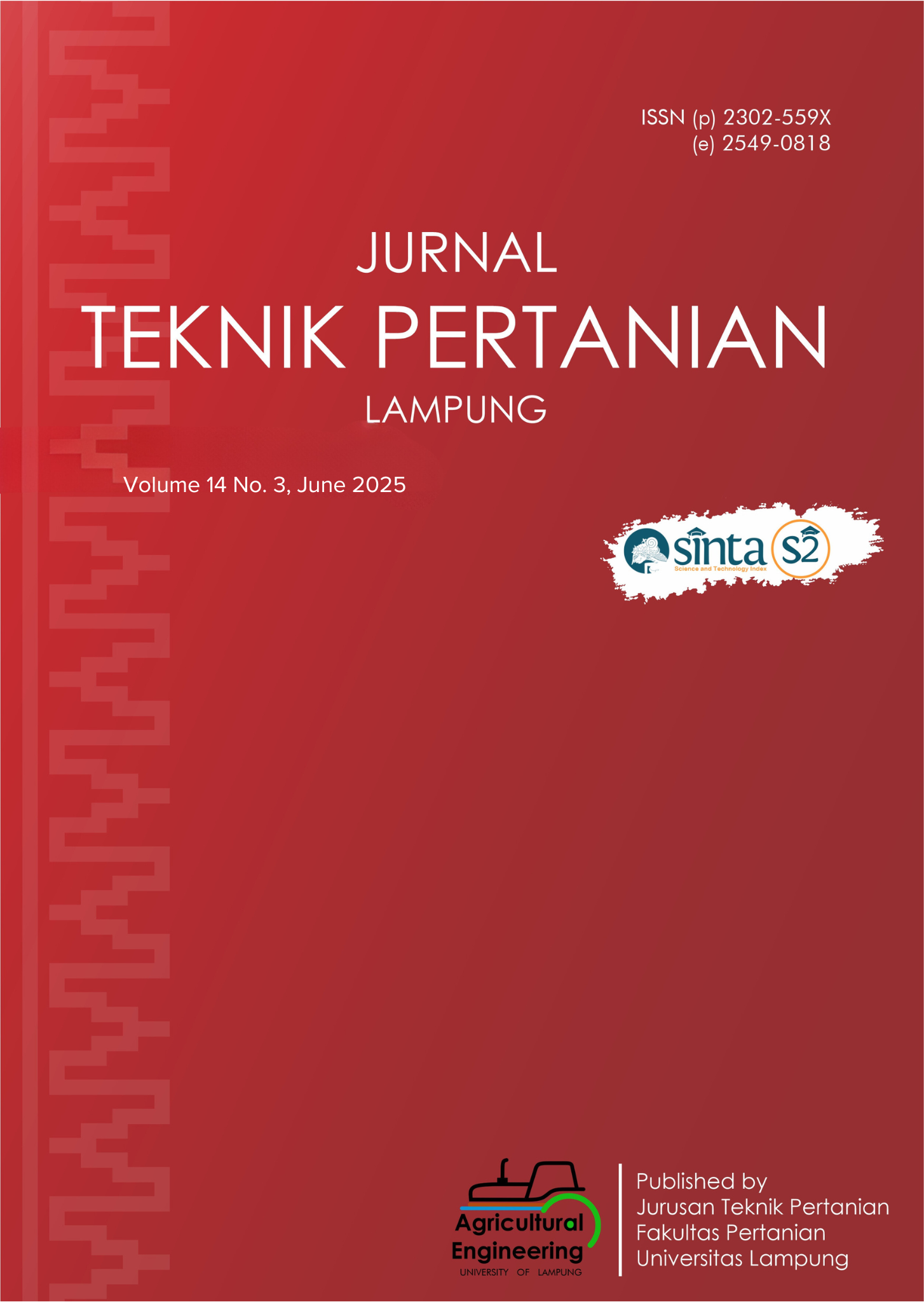Potential Drought of Agricultural Land Due to Soil Damage Based on Land Mapping Unit
DOI:
https://doi.org/10.23960/jtep-l.v14i3.1051-1060 Abstract View: 140
Abstract View: 140
Abstract
Sediment deposition in the upstream river areas can cause drought and disrupt agricultural activities. This study aims to analyze the potential for drought in the Keduang Sub Watershed based on the Land Map Unit. The Keduang Sub-Watershed area has high potential for the development of agricultural land for food crops, but is not free from the potential for drought. The study was conducted using a soil survey method that was strengthened by soil sampling and laboratory analysis. Parameters for determining soil damage that causes the potential for land drought include soil physical properties, namely specific gravity, structure, soil color, porosity, permeability, slope, and soil type. The results showed that the potential for drought at the research location was still high. This is influenced by the level of soil damage that varies from low, medium to high. Land drought can be an obstacle to agricultural activities, and improper land management can worsen the situation. Conservative actions to overcome this problem include the addition of organic matter, crop rotation, application of soil cover or mulch, and processing agricultural land according to the contour direction. These activities are expected to overcome soil damage so that the potential for drought can be overcome.
Keywords: Conservation activities, Land drought, Physic soil properties, Soil damage.
Downloads
References
Aisy, R., Sukmono, A., & Firdaus, H.S. (2023). Analisis perubahan laju erosi pada Sub DAS Keduang tahun 2016 – 2021 dengan metode Universal Soil Loss Equation (USLE). Jurnal Geodesi Undip, 12(2), 111-120.
Auliyani, D., & Wahyuningrum, N. (2019). Sebaran potensi kekeringan meteorologis di Daerah Aliran Sungai Bengawan Solo bagian hulu dan upaya penanggulangannya. Majalah Geografi Indonesia, 33(2), 58-63. https://doi.org/10.22146/mgi.45534
Avicenna, A.K., Hadiani, R., & Solichin, S. (2015). Indeks kekeringan hidrologi di DAS Keduang berdasarkan metode Flow Duration Curve (FDC). Matriks Teknik Sipil, 3(3). Retrieved from https://jurnal.uns.ac.id/matriks/article/view/37283
Azis, A.A.A., Mujiyo, M., Cahyono, O. (2021). Mapping of soil degradation potential in Nguntoronadi District Wonogiri Regency. IOP Conference Series: Earth and Environmental Science, 905(1), 012085. https://doi.org/10.1088/1755-1315/905/1/012085
Badan Pusat Statistik [BPS]. (2019). Kecamatan Nguntoronadi Dalam Angka 2019. Wonogiri: BPS Kabupaten Wonogiri. Retrieved from https://wonogirikab.bps.go.id/id/publication/2019/09/26/729e99174d58d283f31578e2/kecamatan-nguntoronadi-dalam-angka-2019.html
Ebabu, K., Tsunekawa, A., Haregeweyn, N., Tsubo, M., Adgo, E., Fenta, A.A., Meshesha, D.T., Berihun, M.L., Sultan, D., Vanmaercke, M., Panagos, P., Borrelli, P., Langendoen, E.J., & Poesen, J. (2022). Global analysis of cover management and support practice factors that control soil erosion and conservation. International Soil and Water Conservation Research, 10(2), 161–176. https://doi.org/10.1016/j.iswcr.2021.12.002
Gavrilescu, M. (2021). Water, soil, and plants interactions in a threatened environment. Water, 13(19), 2746. https://doi.org/10.3390/w13192746
Gürsu, H. (2024). An Affordable system solution for enhancing tree survival in dry environments. Sustainability, 16(14), 5994. https://doi.org/10.3390/su16145994
Hardjowigeno, S. (2003). Klasifikasi Tanah dan Pedogenesis. Jakarta: Akademika Pressindo.
Hidayat, A.M., Mulyo, A.P., Azani, A.A., Aofany, D., Nadiansyah, R., & Rejeki, H.A. (2018). Evaluasi ketersediaan sumber daya air berbasis metode neraca air Thornthwaite Mather untuk pendugaan surplus dan defisit air di Pulau Jawa. Prosiding SNFA (Seminar Nasional Fisika dan Aplikasinya), 3, 35-46. https://doi.org/10.20961/prosidingsnfa.v3i0.28506
Hossain, A., Krupnik, T.J., Timsina, J., Mahboob, M.G., Chaki, A.K., Farooq, M., Bhatt, R., Fahad, S., & Hasanuzzaman, M. (2020). Environment, climate, plant and vegetation growth. In Agricultural land degradation: Processes and problems undermining future food security (pp. 17–61). Springer. https://doi.org/10.1007/978-3-030-49732-3_2
Hussain, A., Rehman, F., Rafeeq, H., Waqas, M., Asghar, A., Afsheen, N., Rahdar, A., Bilal, M., & Iqbal, H.M. (2022). In-situ, Ex-situ, and nano-remediation strategies to treat polluted soil, water, and air–A review. Chemosphere, 289, 133252. https://doi.org/10.1016/j.chemosphere.2021.133252
Knápek, J., Králík, T., Vávrová, K., & Weger, J. (2020). Dynamic biomass potential from agricultural land. Renewable and Sustainable Energy Reviews, 134, 110319. https://doi.org/10.1016/j.rser.2020.110319
Kurnia, U., Agus, F., & Aimihardja, A. (2006). Sifat fisik tanah dan metode analisisnya. Balai Besar Penelitian dan Pengembangan Sumberdaya Lahan Pertanian (BBSDLP). https://repository.pertanian.go.id/handle/123456789/14955
Loganathan, G.B., Mohan, E., & Kumar, R.S. (2019). IoT based water and soil quality monitoring system. International Journal of Mechanical Engineering and Technology (IJMET), 10(2), 537-541. Retrieved from https://eprints.tiu.edu.iq/698/
McLeod, M.K., Sufardi, S., & Harden, S. (2020). Soil fertility constraints and management to increase crop yields in the dryland farming systems of Aceh, Indonesia. Soil Research, 59(1), 68-82. https://doi.org/10.1071/SR19324
MNLH (Menteri Negara Lingkungan Hidup). (2006). Peraturan Menteri Negara Lingkungan Hidup Nomor 07 Tahun 2006 tentang Tata Cara Pengukuran Kriteria Baku Kerusakan Tanah Untuk Produksi Biomassa. Direktorat Jenderal Kementerian Lingkungan Hidup dan Kehutanan, Jakarta.
MNLH (Menteri Negara Lingkungan Hidup). (2009). Peraturan Menteri Negara Lingkungan Hidup Nomor 17 Tahun 2009 tentang Pedoman Penentuan Daya Dukung Lingkungan Hidup dalam Penataan Ruang Wilayah. Direktorat Jenderal Kementerian Lingkungan Hidup dan Kehutanan, Jakarta.
Morris, G.L. (2020). Classification of management alternatives to combat reservoir sedimentation. Water, 12(3), 861. https://doi.org/10.3390/w12030861
Mujiyo, M., Rahayu, R., & Sutopo, N.R. (2020). Implementasi evaluasi lahan untuk pengembangan komoditas tanaman berdasarkan kesesuaian agroklimat. AgriHealth: Journal of Agri-Food, Nutrition and Public Health, 1(2), 62-70. https://doi.org/10.20961/agrihealth.v1i2.44239
Nugroho, A.P. (2012). Analisis kekeringan Daerah Aliran Sungai Keduang dengan menggunakan metode Palmer. [Undergraduated Thesis]. Universitas Sebelas Maret.
Patra, S.K., Poddar, R., Brestic, M., Acharjee, P.U., Bhattacharya, P., Sengupta, S., Pal, P., Bam, N., Biswas, B., Barek, V., Ondrisik, P., Skalicky, M., & Hossain, A. (2022). Prospects of hydrogels in agriculture for enhancing crop and water productivity under water deficit condition. International Journal of Polymer Science, 2022, 4914836. https://doi.org/10.1155/2022/4914836
Presiden RI (Republik Indonesia). (2000). Peraturan Pemerintah Republik Indonesia Nomor 150 Tahun 2000 tentang Pengendalian Kerusakan Tanah untuk Produksi Biomassa. Lembaran Negara Tahun 2000 Nomor 267, Tambahan Lembaran Negara Nomor 4068.
Rahayu, E.S., Widadie, F., & Setyowati. (2023). Performance of environmentally sound cassava farming as an effort to increase income after covid 19 in the Bengawan Solo Wonogiri Watershed. IOP Conference Series: Earth and Environmental Science, 1180(1), 012007. https://doi.org/10.1088/1755-1315/1180/1/012007
Rahayu, T. (2016). Evaluasi fungsi bangunan pengendali sedimen (Check DAM) Pengkol berdasarkan tata guna lahan Kali Keduang Kabupaten Wonogiri. [Undergraduated Thesis]. Universitas Sebelas Maret.
Rendrarpoetri, B.L., Rustadi, E., Fauzi, A., & Pravitasari, A.E. (2024). Local sustainability assessment of the wonogiri multipurpose reservoir catchment area in Central Java Province, Indonesia. Land, 13(11), 1938. https://doi.org/10.3390/land13111938
Romadhon, M.R., & Aziz, A. (2022). Determination of flood susceptibility index using overlay-scoring data method based on geographic information system (GIS) in Semarang city, Central Java, Indonesia. AgriHealth: Journal of Agri-food, Nutrition and Public Health, 3(2), 104-123. https://doi.org/10.20961/agrihealth.v3i2.60451
Roy, S.K., & Chowdhury, M.A. (2024). Morphometric analysis and watershed delineation of the Karnaphuli river basin: A comparative study using different DEMs in Chittagong, Bangladesh. River, 3, 426–437. https://doi.org/10.1002/rvr2.109
Scala, S.A., Gaudio, C.D., & Verderame, G.M. (2022). Influence of construction age on seismic vulnerability of masonry buildings damaged after 2009 L'Aquila earthquake. Soil Dynamics and Earthquake Engineering, 157, 107199. https://doi.org/10.1016/j.soildyn.2022.107199
Wardani, H.K., & Kurniawati, W. (2014). Kajian desain kawasan berbasis konsep WSUD (Water Sesitive Urban Design) di daerah langka air (Studi kasus: Desa Gambirmanis, Kec. Pracimantoro, Kab. Wonogiri). Ruang, 2(3), 221-230. Retrieved from https://ejournal3.undip.ac.id/index.php/ruang/article/view/5683
Wassie, S.B. (2020). Natural resource degradation tendencies in Ethiopia: A review. Environmental systems research, 9(1), 1-29. https://doi.org/10.1186/s40068-020-00194-1
Wiraatmaja, M.F., Kusumaningrum, L., Herdiansyah, G., Mujiyo, M., Anggita, A., Romadhon, M.R., & Irmawati, V. (2024). Flood vulnerability assessment trough overlay-scoring data method based on Geographical Information System (GIS) in Giriwoyo, Wonogiri, Indonesia. IOP Conference Series: Earth and Environmental Science, 1314(1), 012109. https://doi.org/10.1088/1755-1315/1314/1/012109
Wulandari, A., Lopulisa, C., & Ahmad, A. (2021). Analysis of soil characteristics and classification from order to family category in Makale District. IOP Conference Series: Earth and Environmental Science, 807(4), 042006. https://doi.org/10.1088/1755-1315/807/4/042006
Downloads
Published
How to Cite
Issue
Section
License
Authors who publish with this journal agree to the following terms:
Authors retain copyright and grant the journal right of first publication with the work simultaneously licensed under a Creative Commons Attribution-ShareAlike 4.0 International Lice that allows others to share the work with an acknowledgement of the work's authorship and initial publication in this journal.
Authors are able to enter into separate, additional contractual arrangements for the non-exclusive distribution of the journal's published version of the work (e.g., post it to an institutional repository or publish it in a book), with an acknowledgement of its initial publication in this journal.
Authors are permitted and encouraged to post their work online (e.g., in institutional repositories or on their website) prior to and during the submission process, as it can lead to productive exchanges, as well as earlier and greater citation of published work (See The Effect of Open Access).
Jurnal Teknik Pertanian Lampung

JTEPL is licensed under a Creative Commons Attribution-ShareAlike 4.0 International License.













